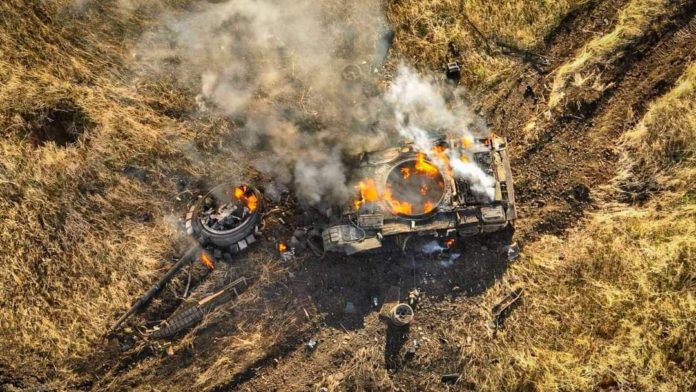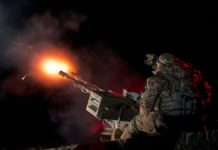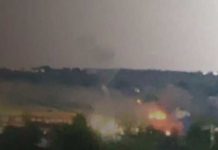April 29, 2025 marks the 1161st day of Russia’s full-scale war against Ukraine. The frontline remains intensely active, with a record number of clashes, mass drone strikes, and heavy air assaults. Ukraine continues its steadfast resistance, successfully destroying enemy personnel and equipment. On the diplomatic front, complex negotiations are ongoing, particularly concerning ceasefire arrangements and economic partnership with the United States.
Frontline Situation
On the 1161st day of the war, Ukrainian forces are conducting a high-intensity defense along the entire frontline. The enemy’s most active operations are concentrated in eastern Ukraine, where it launched 178 attacks over the past 24 hours. Key targets included Donetsk, Sumy, Zaporizhzhia, and Kherson regions. Russia carried out massive airstrikes, artillery barrages, and kamikaze drone assaults.
Key combat directions:
- Pokrovsk axis saw the heaviest fighting with 59 attacks. Russian troops attempted to breach Ukrainian defenses near Sukhyi Yar, Malynivka, Lysivka, and in the direction of Pokrovsk.
- Lyman axis: 18 assaults were repelled near Katerynivka, Kolozi and Yampilivka.
- Novopavlivka axis: 23 attacks were recorded around Pryvilne and Vilne Pole.
- Kramatorsk axis: heavy combat occurred near Markove, Chasiv Yar, and Bila Hora.
- Kupiansk, Siversk, and Kharkiv axes: over 20 total assaults, including near Vovchansk, Petropavlivka, and Ivano-Daryivka.
- Orikhiv and Dnipro River axes: 10 assaults were successfully repelled by Ukrainian troops.
- Huliaipole axis: no major combat activity.
Russia launched more than 6,000 attacks, including 115 airstrikes and over 2,800 kamikaze drones. Numerous towns and villages were struck, including Pokrovsk, Huliaipole, Naumivka, and Olhivka.
Despite continued Russian offensives, Ukraine maintains control along critical sectors, inflicting heavy losses and successfully halting enemy breakthroughs. Defensive operations remain intense as Ukrainian forces repel numerous assaults and carry out deep-strike missions.
Russian Losses
According to the Ukrainian General Staff on the morning of April 29, 2025, Russia’s combat losses in the past 24 hours include:
- Personnel — 950,860 (+1,060)
- Tanks — 10,728 (+5)
- Armored vehicles — 22,352 (+14)
- Artillery systems — 27,080 (+42)
- MLRS — 1,373 (no change)
- Air defense systems — 1,146 (+1)
- Aircraft — 370 (no change)
- Helicopters — 335 (no change)
- Tactical UAVs — 34,177 (+94)
- Cruise missiles — 3,196 (no change)
- Ships/boats — 28 (no change)
- Submarines — 1 (no change)
- Vehicles/fuel trucks — 46,432 (+140)
- Special equipment — 3,860 (no change)
These losses underscore Ukraine’s effective defense operations, particularly in neutralizing Russian artillery, drones, and armored units.
Ukrainian Strikes & Enemy Targets Destroyed
Over the past 24 hours, Ukraine’s Defense Forces conducted precision strikes on Russian positions:
- Strikes hit 16 Russian personnel and equipment concentration areas.
- One air defense system and two artillery units were destroyed.
- During a night drone attack involving 100 UAVs, Ukrainian air defenses downed 37, while 47 others were lost.
- Deep operations continue in Russia’s Kursk region, where explosions and fires were reported in rear logistics zones.
These achievements highlight Ukraine’s ability to damage enemy infrastructure and logistics both at the front and in occupied or hostile rear areas.
Diplomatic Negotiations
As of April 29, 2025, diplomatic efforts to end the war have intensified but remain difficult due to major divergences between Ukraine and Russia and growing pressure from global stakeholders.
- Russia announced a unilateral ceasefire from May 8–10, marking WWII Victory Day. Ukraine criticized the short duration and demanded an immediate 30-day truce for substantive negotiations.
- U.S. President Donald Trump increased pressure on Ukraine to sign a peace deal, warning of potential cuts in military aid. This caused concern among European allies.
- Ukraine reaffirmed readiness to negotiate if a full ceasefire is enforced. President Volodymyr Zelenskyy emphasized the need for security guarantees and full Russian withdrawal.
- EU, Canada, and Japan held behind-closed-doors talks in Vienna to coordinate peace efforts. The EU presidency confirmed “alignment of positions.”
- China’s envoy Li Hui again proposed a phased freeze of the conflict. Ukraine responded cautiously, reaffirming its demand for full territorial integrity.
Despite increasing diplomatic activity, no breakthrough has been reached. Ukraine insists on firm preconditions, while several global actors continue pushing for compromise formats.
International Support for Ukraine
As of April 29, 2025, international support for Ukraine remains crucial amid U.S. aid uncertainties. European partners are intensifying efforts to maintain stable defense and financial assistance.
- Germany pledged €3 billion in additional military aid as part of long-term support.
- United Kingdom issued a second defense loan tranche worth £752 million (~$990 million USD) to help procure air defense systems and artillery.
- Belgium announced a €1 billion assistance package, underscoring Europe’s expanding role as U.S. funding becomes uncertain.
- IMF approved a $400 million disbursement after completing the latest program review to support Ukraine’s budget.
- U.S.-Ukraine economic partnership talks continue, exploring a joint investment fund financed by Ukrainian resource revenues. The deal excludes repayment for prior U.S. assistance and aligns with Ukraine’s EU obligations.
This growing European and institutional support helps stabilize Ukraine’s economy and sustain defense capacity under ongoing hostilities.
Humanitarian Situation in Ukraine
As of April 29, 2025, Ukraine’s humanitarian situation remains dire due to continued Russian strikes on civilians and infrastructure:
- Russia launched a large-scale UAV attack involving 100 drones overnight. Kharkiv, Donetsk, Dnipropetrovsk, and Kyiv regions were affected. A 12-year-old girl died in a residential building hit in Dnipropetrovsk. A 6-year-old boy and three adults were rescued but injured. In Nikopol, a 47-year-old woman was wounded.
- According to the UN, from April 1–24, at least 848 civilian casualties were recorded — 151 killed and 697 injured — a 46% increase year-on-year. The April 24 attack on Kyiv accounted for significant losses.
- The Ukrainian government adopted a new policy to reallocate unused humanitarian aid between organizations or return it to donors if distribution is impossible.
Despite efforts by the Ukrainian government and international partners, large-scale strikes continue to inflict high civilian casualties and damage critical infrastructure.
Domestic Situation in Ukraine
Mobilization & Personnel Reforms
- Territorial center reviews: The General Staff launched checks on military recruiters lacking combat experience. Eligible officers may be reassigned to frontlines and replaced by injured veterans.
- Student draft exemptions: Authorities plan to limit exemptions for students over 25.
- Mobilization of men 50+: From May 1, Ukraine will draft men over 50 with key skills, especially communications.
- Basic military training: From September 1, a nationwide training program will begin for citizens aged 18–25. It will last up to five months in peacetime and three during wartime.
Economy
- 2024 war spending: Ukraine’s defense expenses reached $64.7 billion in 2024 (+2.9% YoY).
- Defense procurement savings: The Defense Ministry saved ₴180 million ($4.5 million) through early 2025 by improving oversight.
- CBAM challenge: Ukrainian mining firms urged talks with the EU to delay implementation of the carbon border tax mechanism.
- Currency exchange: As of April 29 — USD: 38.50 UAH, EUR: 41.20 UAH, PLN: 9.10 UAH.
Social Reforms
- Educational guarantees for servicemen: A draft law ensures that soldiers aged 18–25 retain university places and scholarships.
- Social assistance reform: The government continues to streamline welfare to ensure targeted and transparent distribution.
Ukraine’s domestic landscape reflects continued adaptation to wartime conditions. Mobilization, fiscal control, and support for military personnel remain top priorities.
Conclusion
The 1161st day of war showcased high-intensity combat, record drone use, and expanded international diplomacy. Ukraine effectively repelled Russian assaults and conducted successful counter-strikes. While no diplomatic resolution has emerged, Ukraine receives growing support from Europe and financial institutions. Internally, Kyiv strengthens its mobilization and reform agenda to sustain national resilience amid ongoing war.
🤝 SUPPORT US 💙💛
We continue to work only because you read and support us. If you appreciate what we do, please become our sponsor or donate here👇
☕️ buymeacoffee.com/meaninuak
or
☑️ patreon.com/MeanwhileinUkraine
Your support helps us continue delivering timely and accurate updates. Stay informed and stand with Ukraine! 🇺🇦
Together we are stronger! 🇺🇦

























